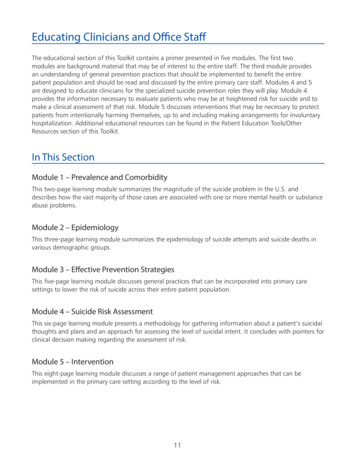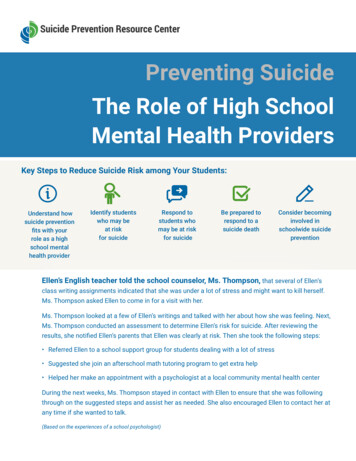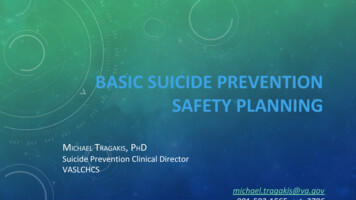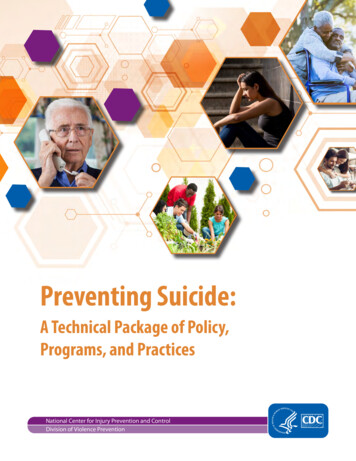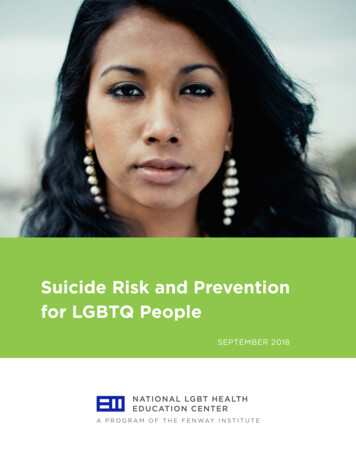
Transcription
Suicide Risk and Preventionfor LGBTQ PeopleSEPTEMBER 2018
IntroductionIt may come as no surprise that lesbian, gay, bisexual, transgender, and queer (LGBTQ) peopleare vulnerable to suicidal thoughts and behavior. In recent years, the media and social campaignshave highlighted the tragic suicides of several young LGBTQ people who ended their lives becauseof relentless bullying or family rejection. Preventing suicide and enhancing resilience is clearly oneof the most critical aspects of health care provision for LGBTQ patients. Health centers have anopportunity to provide programs and care with the goal of promoting self-acceptance, positivesocial engagement, and improved mental and physical health of LGBTQ people in the community.This publication offers a brief summary of what is known about suicidal behavior and risk amongLGBTQ people, followed by information and resources for health centers to help both young andold LGBTQ people get support and tap into internal and community resilience.What is known?Actual suicide rates among LGBTQ people are not known because sexual orientation and genderidentity are not reported in death records.1 What we do know about suicidality among LGBTQ peopleis through surveys in which people self-report suicide attempts and ideation. According to a numberof regional and national studies, LGBTQ adults and youth face an extraordinarily elevated risk ofsuicidal thoughts and behavior.1,2 LGBQ adults have a two-fold excess risk of suicide attempts compared to other adults.3 Among transgender adults, the lifetime prevalence of suicide attempts is 40%.4Suicide risk in LGBTQ people is thought to be highest during the teen years and early 20s. In 2015,more than 4.5 times as many LGB-identified high school students reported attempting suicide inthe past 12 months compared to non-LGB students (29.4% vs 6.4%); 42.8% of LGB youth seriouslyconsidered suicide.5 Youth who are bisexual or questioning their sexual orientation and/or genderidentity are even more likely to experience depression or suicidality than their LG-identified peers.6An often overlooked population when discussing suicide are older LGBTQ adults (65 years and over).Older adults in the general population accounted for close to 17% of fatal suicides even though theycurrently make up about 15% of the total U.S. population.7 Again, the percentage of completedsuicides in LGBTQ people is unknown; however, older LGBTQ adults have endured a long life ofstigmatization, and some studies have found higher rates among LGB older adults compared totheir straight peers.8Why are LGBTQ people at high risk?Research has found multiple factors associated with suicidal behavior among LGBTQ people, including isolation from family and peers, a history of mental health issues (e.g., depression and anxiety),substance use disorders, and victimization (e.g., being the target of bullying; being abused).1,9-11 All ofthese risk factors stem from the stress created by living as a stigmatized minority (often referred toas minority stress).13 Even today, with increased awareness and social acceptance in the U.S., manyLGBTQ people find they must contend with harassment, discrimination, and bias enacted by peers,family, colleagues, workplaces, houses of worship, schools, places of public accommodation, andhealth care settings.6,12 Anti-LGBTQ attitudes can become internalized, leading to further stress andpotential for suicidal thoughts.132
What can health centers do?Health centers can make an important difference in the lives of their patients by training providers toscreen, assess, and address suicidal ideation in LGBTQ patients, and by creating programs or resource/referral lists to enhance social support and self-acceptance. In addition, health centers can make organization-wide structural changes that communicate safety and inclusion for sexual and gender minorities.ScreeningThere are no LGBTQ-specific screening mechanisms forsuicidality. However, because LGBTQ people are more atrisk, health centers should have reliable systems for routinelycollecting information on the sexual orientation and gender identity (SO/GI) of their patients, and using that data toinform care. For resources on best practices for SO/GI datacollection, go to: www.lgbthealtheducation.org/sogi.Warning signs and risk factors for suicide include hopelessness, history of suicide attempts, co-occurring mental healthand substance use disorders, history of physical or emotionalabuse, lack of social support, and access to firearms or otherlethal means. Patients who report the following criteria maybe at greatest risk, especially if the thoughts are new, haveincreased, or seem related to a painful event, loss, or change:nn Life is too difficultnn Wanting to be deadnn Thoughts of ending own life.14More information on suicide risk, prevention, and screeningtools can be found on the Substance Abuse and MentalHealth Administration’s (SAHMSA) Suicide Prevention page:https://www.samhsa.gov/suicide-prevention.3
Treatment and SupportBuilding resilience in LGBTQ people can set them on a path to better mental health and life adjustment.Factors that strongly protect LGBTQ people, especially youth, against spiraling into depression andsuicidal behavior include:nn Acceptance by family of origin (e.g., parents, siblings, grandparents, children)15nn Having a supportive social network made up of LGBTQ friends, allies, and family of choice(close relationships with people who are not biologically related but who act as a family)8,16,17nn Access to and use of LGBTQ inclusive medical and mental health.17Fortunately, resiliency factors can be enhanced through access to LGBTQ-affirming counseling andtherapy, medical care, and LGBTQ-specific resources.Behavioral health providers can use “minority stress treatment principles” when caring for LGBTQyouth and adults as a way to minimize the impact of stigma and discrimination:nn Normalize adverse impact of minority stressnn Validate unique strengths of LGBTQ peoplenn Facilitate emotional awareness, regulation,nn Foster supportive relationships and communityand acceptancenn Empower assertive communicationnn Affirm healthy, rewarding expressions ofsexuality and gender.18nn Restructure minority stress cognitionsAlthough a high percentage of LGBTQ people think about or attempt to take their lives in reaction tostigmatizing and stressful life experiences, it is also important for providers to keep in mind that mostLGBTQ people find inner resilience, social support, and other ways to cope, and do not become suicidal.19In addition to behavioral health providers, all other health center employees, including clinical andnon-clinical staff, should learn to provide LGBTQ-affirming care. LGBTQ patients are more likely toaccess care in health centers that make intentional efforts to be inclusive and welcoming. For freeonline training and publications, go to: www.lgbthealtheducation.org.4
Validating GriefLGBTQ people who have lost a partner/spouse or other loved one often do not have the same types ofsupport as non-LGBTQ people. Due to societal stigma, some LGBTQ people will feel they cannot openlyacknowledge or publicly mourn a partner, or may find that others minimize their loss – a problem oftenreferred to as disenfranchised grief.20 Such disenfranchised grief is common among those who survivedthe HIV/AIDS crisis but lost so many of their peers. Losing a loved one from suicide further disenfranchises grief because of the stigma associated with mental illness and suicide. In addition, disenfranchised grief itself may be a risk factor for suicide.20Providers should be careful to validate a patient’s grief, even if they cannot relate to the situation. Forexample, many LGBTQ people—especially those without children – develop strong relationships to theirpets, and may go through an intense mourning period when a pet dies. Others may grieve deeply overa friend who was part of their family of choice.5
Bereavement Support GroupsHealth centers can consider holding support groups for LGBTQ people experiencing grief. The Massachusetts Department of Public Health’s Suicide Prevention program and Fenway Health’s LGBT AgingProject have developed a model for LGBTQ Bereavement Support Groups. Facilitated by a licensedsocial worker experienced in LGBTQ end of life and bereavement issue, these groups run for 6-8 weeksin community spaces. The groups include adult members of all ages, and give people a space to discussfeelings of loss, conflicted feelings about estranged family members, and legal issues (especially if theloved one was not legally or biologically related). Suicidal thoughts arise for some, and clinical referralsare made to ensure their safety. Members report tremendous appreciation for having an LGBTQ-inclusivespace where they feel “known” and can bring their authentic selves and relationships.6
National ResourcesHealth centers can support their LGBTQ patients by keeping local and national resources on hand, such as the onesprovided here. In addition, providers in need of additional education and training can access materials and additionallearning resources from the sites mentioned below.For LGBTQYouthnn The Trevor Project: www.thetrevorproject.org 24-hour, toll-free, crisis intervention phone line: 1.866.488.7386 Online, social networking community for LGBTQ youth (13 to 24 years) and allies Educational programs for schoolsnn Peer Listening Line: lp-lines Anonymous and confidential help line for accessing support from other LGBTQ youth (not specific tosuicide): 800.399.PEER Offers LGBTQ young people a safe place to call for information, referrals, and support with coming out,locating LGBTQ groups and services, safer sex and relationships, and HIV/AIDS.nn It Gets Better Project: https://itgetsbetter.org A nonprofit organization that empowers and connects LGTBQ youth through education andinspiring stories.For Everyonenn National Suicide Prevention Lifeline: https://suicidepreventionlifeline.org 24 hour, toll-free crisis line: 1.800.273.8255 National network of local crisis centers that provides free and confidential emotional support to peopleand their families in suicidal crisis or emotional distressnn LGBT Helpline: lp-lines Anonymous and confidential help line for accessing support from other LGBTQ people (not specific tosuicide): 888.340.4528 Offers information, referrals, and support with coming out, locating LGBTQ groups and services, safer sexand relationships, and HIV/AIDS.For Familiesof LGBTQPeoplenn PFLAG: www.plag.org Organization dedicated to promoting family and community support and acceptance of LGBTQ peoplethrough education, support groups, and advocacy.nn Family Acceptance Project: https://familyproject.sfsu.edu A research, intervention, education and policy initiative that works to prevent health and mental healthrisks for LGBTQ children and youth in the context of their families, cultures, and faith communities. Provides training and consultation on an evidence-based family model of wellness, and prevention andcare to strengthen families and promote positive development.For Health CareProviders andOrganizationsnn American Foundation for Suicide Prevention: LGBT Initiative: www.afsp.org Multiple LGBTQ-specific resources, including mental health educational resources and training toolsnn SAMHSA: Suicide Prevention: www.samhsa.gov/suicide-prevention Information and resources on suicide prevention and risk for behavioral health professionals,the general public, and people at risk.nn National Strategy for Suicide Prevention: or-Action/PEP12-NSSPGOALS Report outlining a national strategy to guide actions for suicide prevention, with objectives and goalsacross four strategic directions: wellness and empowerment, prevention services, treatment and supportservices, and surveillance.nn Suicide Prevention Resource Center (SPRC): Suicide Prevention among LGBT orkshop Workshop for Professionals Who Serve Youth: free workshop kit to help staff in schools, youth-servingorganizations, and suicide prevention programs take action to reduce suicidal behavior among LGBTQ youth.7
References1.Haas AP, Eliason M, Mays VM, et al. Suicide and suicide risk in lesbian, gay, bisexual, and transgender populations: review and recommendations. Journal of Homosexuality. 2010;58(1):10-51.2.Mathy RM: Suicidality and sexual orientation in five continents: Asia, Australia, Europe, North America, and South America. International Journal of Sexuality and Gender Studies. 2002, 7 (2–3): 215-225.3.King M, Semlyen J, Tai SS, et al. A systematic review of mental disorder, suicide, and deliberate self harm in lesbian, gay and bisexualpeople. BMC Psychiatry. 2008;8:70.4.James S, Herman JL, Rankin S, et al. The Report of the 2015 U.S. Transgender Survey. Washington, DC: National Center for TransgenderEquality;2016.5.Kann L, Olsen EO, McManus T, et al. Sexual identity, sex of sexual contacts, and health-related behaviors among students in grades9-12 – United States and selected sites, 2015. MMWR Surveill Summ. 2016;65(9):1-202.6.Kann L, Olsen EO, McManus T, et al. Sexual identity, sex of sexual contacts, and health-risk behaviors among students in grades9-12--youth risk behavior surveillance, selected sites, United States, 2001-2009. MMWR Surveill Summ. 2011;60(7):1-133.7.Centers for Disease Prevention and Control. Fatal Injury Reports, 1999-2016. Available at https://www.cdc.gov/injury/wisqars/fatal.html. Accessed April 30, 2018.8.Fredriksen-Goldsen KI, Muraco A. Aging and sexual orientation: a 25-year review of the literature. Res Aging. 2010;32(3):372-413.9.Fergusson DM, Horwood LJ, Beautrais AL. Is sexual orientation related to mental health problems and suicidality in young people?Arch Gen Psychiatry. 1999;56(10):876-880.10. Fergusson DM, Horwood LJ, Ridder EM, Beautrais AL. Sexual orientation and mental health in a birth cohort of young adults. PsycholMed. 2005;35(7):971-981.11.D’Augelli AR, Hershberger SL, Pilkington NW. Suicidality patterns and sexual orientation-related factors among lesbian, gay and bisexual youths. Suicide Life Threat Behav. 2001; 31(3): 250–264.12. GLAAD. Accelerating Acceptance 2018: A survey of American acceptance and attitudes toward LGBTQ Americans (conducted by theHarris poll). Available at 02018.pdf. Accessed April 30, 2018.13. Hatzenbuehler ML, Pachankis JE. Stigma and minority stress as social determinants of health among lesbian, gay, bisexual, and transgender youth: research evidence and clinical implications. Pediatr Clin North Am. 2016;63(6):985-997.14. Substance Abuse and Mental Health Services Administration (SAMHSA): Suicide Prevention. Available at www.samhsa.gov/suicide-prevention. Accessed April 30, 2018.15. Ryan C, Russell ST, Huebner D, Diaz R, Sanchez J. Family acceptance in adolescence and the health of LGBT young adults. J Child Adolesc Psychiatr Nurs. 2010;23(4):205-213.16. Toomey RB, Ryan C, Diaz RM, Russell ST. High school Gay-Straight Alliances (GSAs) and young adult well-being: an examination ofGSA presence, participation, and perceived effectiveness. Appl Dev Sci. 2011;15(4):175-185.17. Bockting W, Coleman E, Deutsch MB, et al. Adult development and quality of life of transgender and gender nonconforming people.Curr Opin Endocrinol Diabetes Obes. 2016;23(2):188-197.18. Pachankis JE. Uncovering clinical principles and techniques to address minority stress, mental health, and related health risks amonggay and bisexual men. Clin Psychol 2014;21(4):313-330.19. Movement Advancement Project. Talking about suicide & LGBT populations, second edition; 2017. Available at -about-suicide-and-lgbt-populations. Accessed April 30, 2018.20. Doka, KJ. Disenfranchised Grief: Recognizing hidden sorrow. Lexington, MA: Lexington Press, 1989.8
This project was supported by the Health Resources and Services Administration (HRSA) of the U.S. Department of Healthand Human Services (HHS) under cooperative agreement number U30CS22742, Training and Technical Assistance NationalCooperative Agreements (NCAs) for 449,994.00 with 0% of the total NCA project financed with non-federal sources.This information or content and conclusions are those of the author and should not be construed as the official positionor policy of, nor should any endorsements be inferred by HRSA, HHS, or the U.S. Government.TFIE-8
chusetts Department of Public Health's Suicide Prevention program and Fenway Health's LGBT Aging Project have developed a model for LGBTQ Bereavement Support Groups. Facilitated by a licensed social worker experienced in LGBTQ end of life and bereavement issue, these groups run for 6-8 weeks in community spaces.
